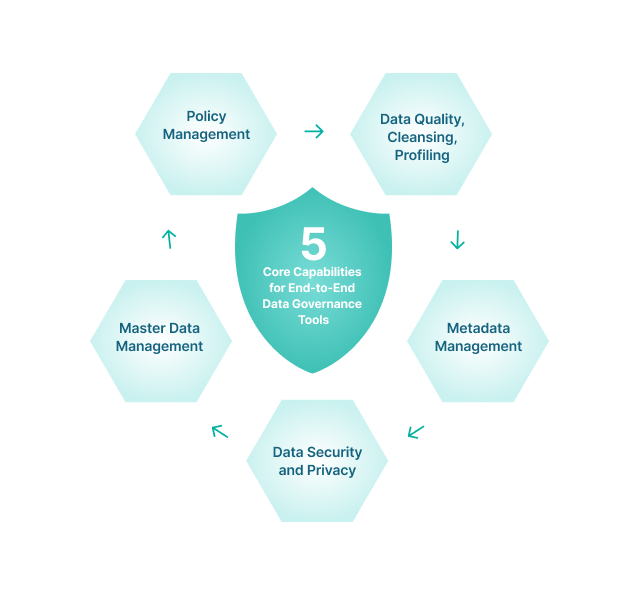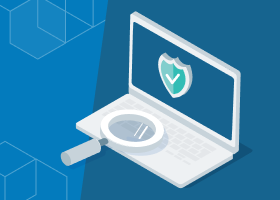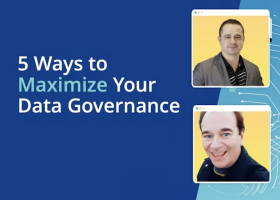Selecting the Best Data Governance Tool
A data governance tool is mandatory for any organization that wants to take data management to the next level. Otherwise, success beyond the most rudimentary data management program is nearly impossible. But, selecting a data governance tool that is the right fit can be overwhelming.

This guide provides the required information to make an educated decision when selecting a data governance tool. It offers expert insights related to the process of evaluating and implementing the tool, including:
- A review of what data governance is
- The primary drivers for implementing a data governance tool
- Results realized with a data governance tool
- Must-have features in a data governance tool
- Questions to consider when assessing data governance tool vendors
| What Is a Data Governance Tool? A data governance tool is a software application that provides management and automation capabilities to help data teams organize data to ensure availability, security, and integrity. Data engineering and operations teams use data governance tools to support the deployment and customization of data governance frameworks that automatically enforce data governance policies across the entire data ecosystem. |
Let’s jump in and learn:
- Understanding Data Governance
- Why Organizations Need Data Governance Tools
- Creating a Data Governance Policy
- Benefits of a Data Governance Tool
- Must-Have Features in a Data Governance Tool
- Other Considerations for Selecting the Best Data Governance Tool
- Data Governance Tools: Custodian of the Crown Jewels
Understanding Data Governance
Data governance helps organizations to better manage the availability, usability, integrity, and security of their enterprise data. Technology, such as a data governance tool, allows organizations to effectively and efficiently embed data governance into all of their workflows.
In addition to being foundational to a data governance program, these requirements align with compliance requirements that are driven by internal standards, industry guidelines, or legislation. To adhere to compliance requirements and potential litigation, it is often necessary for data to be searchable, delivering results for any purpose quickly and accurately.
To be successful, data governance requires the ability to answer a number of questions about data, including the following.
- How did it originate?
- What does it contain?
- Is it protected by data privacy standards, such as GDPR or CCPA?
- How accurate is it?
- Where is it located?
- Who has access to it?
- How long should it be retained?
- How can the data be used to make improvements across the organization?
Data governance takes information management to the next level to optimize and support strategic business and operational functions, such as:
- Data access
Controlling how data is stored, retrieved, and used - Data integrity
Maintaining and assuring the veracity, accuracy, and quality of data - Data lineage
Managing the origin of data, what happens to it, and where it moves - Data loss prevention (DLP)
Controlling the transfer of sensitive data - Data security
Protecting against unauthorized access or changes to data - Data synchronization
Creating and maintaining consistency across all data - Master data management (MDM)
Establishing and enforcing processes, policies, standards, and tools for defining, governing, and managing data
Why Organizations Need Data Governance Tools
The volume of data produced, collected, and maintained by most organizations is far more than can be effectively managed with manual processes and procedures. Organizations need data governance tools to provide the automation and management that’s necessary to organize, protect, and use their data.
Data governance tools help organizations get the most out of data, using it as a strategic advantage and for streamlining operations across all departments. Among the ways a data governance tool can help an organization optimize data usage are the following.
- Enable internal collaboration
- Facilitate data sharing across ecosystems
- Direct and manage commercialization of approved data
- Serve as the basis for Artificial Intelligence (AI)-driven decision-making
- Maintain trust of employees, partners, and customers that their data is safe and being used responsibly, ethically, compliantly, and with accountability
- Provide data discovery, access, and cataloging capabilities
- Support stewardship, policy, and overall governance management
- Use enterprise data governance and data literacy programs to gain a better understanding of digital data assets
Several more specific organizational objectives drive the need for a data governance tool to help define, manage, and enforce policies that:
- Ensure that data is used properly.
- Prevent data errors and the misuse of personal or sensitive data.
- Maintain compliance with all regulatory requirements.
- Improve data security.
- Stop unauthorized data access.
- Establish data distribution policies.
Data governance tools not only help organizations to fully leverage their digital assets. The tools also help organizations to meet strict compliance requirements, which continue to expand on all fronts—internal, industry, and government. The associated rules and regulations include stringent requirements for data management that, in many cases, can only be effectively met and managed with a data management tool.
The scope of compliance has expanded from an initial focus on technical aspects, such as master data management, data catalogs, and data quality, to include more challenging requirements such as privacy, protection, and sovereignty.
Several of the major compliance regulations that a data governance tool helps organizations wrangle are:
- European Union’s General Data Protection Regulation (GDPR)
- California Consumer Privacy Act (CCPA)
- California Privacy Rights Act (CPRA)
- Colorado Privacy Act (CPA)
- Virginia Consumer Data Protection Act (VCDPA)
- Children’s Online Privacy Protection Act (COPPA)
- Fair Credit Reporting Act (FCRA)
- Family Educational Rights and Privacy Act (FERPA)
- Gramm-Leach-Bliley Act (GLBA)
- Payment Card Industry Data Security Standard (PCI DSS)
Health Insurance Portability and Accountability Act (HIPAA)
Creating a Data Governance Policy
When creating a governance policy, it is important that it clearly documents a robust set of guidelines for ensuring that an organization’s data and information assets are managed consistently and used properly. A data governance policy formally outlines how to carry out data processing and management workflows.
The group that defines the criteria for a data governance policy is called a data governance committee, or data governance council. It is primarily made up of business executives, business unit heads, and other data constituents and stewards from across the organization. It should include representatives from groups responsible for:
- Compliance
- Finance
- IT
- Legal
- Privacy
- Risk
- Security
A data governance policy typically articulates the principles, practices, and standards that organizational leaders determine are needed to ensure that the organization has high-quality data and that its data assets are protected. It defines the data governance structure for the executive team, managers, and others to follow. This includes policies for:
- Access
- and recovery
- Compliance requirements
- Data quality
- Privacy
- Risk management
- Security
- Usage
Many data governance councils build their data governance policy using frameworks that are included in data governance tools. A data governance policy framework identifies the elements that need to be addressed and provides guidelines for determining the standards and procedures that will work for an organization’s unique needs. A data governance tool’s frameworks include:
- Categories for data, such as sensitive, confidential, or publicly available
- Data access parameters to establish which roles can access which data elements
- Direction on data integration
- Directives on acceptable data usage
- Goals and objectives of the organization’s data governance program
- Inventory of the data sources within the organization
- Laws and regulations that must be followed to meet compliance requirements
- Levels of security and protection required for each data category
- Metrics for determining success, including key performance indicators (KPIs)
- Positions within the organization that will oversee the data governance program
- Processes for monitoring data governance policies
- Protocols for data lifecycle management
- Standards for data quality and data integrity
A well-crafted data governance policy will provide a framework that ensures the following as established by the data governance council.
- Appropriate level of oversight of the organization’s data assets according to value, risk, and compliance requirements
- Consistent, efficient, effective, and continuous oversight and management of the data assets throughout the organization
- Data protection and privacy controls for different categories of data
- Support for the organization’s strategic vision for its data program, such as:
- Fueling digital transformation
- Leveraging data to glean insights that drive new revenue
- Using data to update and provide new services
It is important to remember that a data governance policy is a living document. The data governance policy needs to be flexible and continuously reflect an organization’s specific requirements.
Benefits of a Data Governance Tool
The ultimate benefit of a data governance tool is to realize corporate data governance objectives, including achieving transparency, compliance, and security, as well as supporting data discovery, access, and collaboration.
Ten additional benefits of using a data governance tool include the following.
1. Drives business results
2. Enables real-time data availability
3. Enhances operational efficiency
4. Improves financial performance
5. Increases data quality
6. Makes data consistent, accurate, and complete
7. Maximizes profits
8. Optimizes data to facilitate decision making
9. Saves time and money
10. Supports business planning efforts
Must-Have Features in a Data Governance Tool
Five core capabilities required for end-to-end governance are:
1. Data Quality
Keeps data complete and accurate
Improves data-driven decision making and actions by assessing and cleansing data assets
2. Data Security and Privacy
Protects digital information from unauthorized access, corruption, or theft throughout its entire lifecycle
Manages data encryption, hashing, tokenization, and key management
Regulates access to sensitive data by creating customized access policies and enforcing them across the entire data platform
3. Master Data Management
Centralizes data
Organizes data
Categorizes data
Localizes data
Synchronizes data
Enriches data
4. Metadata Management
Establishes policies and processes to ensure that data can be integrated, accessed, shared, linked, analyzed, and maintained effectively
Describes data, emphasizing associations and lineage
Makes data easy to understand and access
5. Policy Management
Oversees operationalizing of data governance
Ensures that governance follows established, standardized, and consistent processes and policies
Supports organizational alignment around data policies, such as data retention, data usage, integration into applications, access and permissions, and sensitive data handling

Additional must-have features in a data governance tool are the following:
Sensitive Data Discovery
Automates the process of identifying, classifying, and tagging sensitive data when a new data source is exposed to a data governance tool. The sensitive data discovery feature automatically detects sensitive attributes and applies existing governance policies to that data.
This automation eliminates the need for time-consuming, costly manual identification, classification, and tagging of sensitive data. It also accelerates the data life cycle and reliably enforces data governance policies at scale.
Data Catalog
A collection of metadata, combined with data management and search tools, a data catalog allows authorized users to browse an organization’s available data and access data sources (based on privileges) using a self-service model. It also allows users to request access to additional data outside of their access privileges.
A data catalog is an important data governance tool, as it helps to break down silos in an organization by enhancing data visibility. This makes it easier for users to access all available data and supports cross-department collaboration.
Dynamic Data Masking
With dynamic data masking, sensitive data values are removed, anonymized, or otherwise masked from users who are not authorized to access it. Dynamic data masking capabilities, like differential privacy and k-anonymization, allow policies to be built that automatically hide sensitive data.
Auditing and Reporting
A data governance tool should include features that gather real-time insights on data use to facilitate adherence to security and compliance requirements. Auditing and reporting capabilities help track who is accessing which data, when they are accessing it, and how it is being used. Data governance tools should be able to automatically generate data audit reports to maximize visibility into data utilization across the organization.
A few more must-have features in a data governance tool are:
- Ability to manage enterprise-scale data volumes
- Capability to tie business definitions with a technical catalog
- Cloud, on-premises, and hybrid deployment options
- Data connectors
- Ease of deployment and ease of use for business users and IT audiences
- Lineage and reverse lineage
- Reporting capabilities, including visualization
- Robust customization options
- Stewardship management
- Support of data compliance reporting
- Templates and models for data governance frameworks
Other Considerations for Selecting the Best Data Governance Tool
Internal Considerations with Selecting a Data Governance Tool
- What is the driver for implementing a data governance tool?
- Who are the key data governance constituents in the organization?
- What are the organization’s primary use cases?
- What internal resources are available to manage the data governance tool?
- What budget is allocated for the data governance tool and its supporting services?
- What tools are already in place, and what data governance capabilities do they offer?
- Are there technical restrictions and controls for new technology (e.g., what deployment models are supported)?
Vendor Considerations with Selecting a Data Governance Tool
- What are the top data governance tools?
- Does the vendor have deep experience in the data governance space?
- Are there any data governance tools specifically designed for the organization’s industry?
- Which vendor has the best cultural fit?
- Which vendor has the best product fit? (e.g., Does the product support integration with third-party solutions?)
- Does the vendor offer implementation and post-deployment services?
- How does the vendor handle product updates, patches, and bug fixes?
Data Governance Tools: Custodian of the Crown Jewels
It is a widely held belief that data is one of an organization’s most valuable assets. Data plays a pivotal role in everything from enabling the creation and optimization of new products and services to defining strategy and financial tuning.
A data management tool is the linchpin in any serious data management program. Playing a role in nearly every facet of the data lifecycle, a data governance tool brings the automation, organization, and oversight capabilities that are required to successfully and securely shepherd data through all of its phases.
Egnyte has experts ready to answer your questions. For more than a decade, Egnyte has helped more than 16,000 customers with millions of customers worldwide.
Last Updated: 11th April, 2022




